 |
IN NEW ENGLAND | 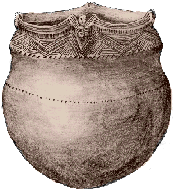 |
 |
IN NEW ENGLAND |  |
Pottery was first used by New England Native Americans about 3,000 years ago. During the Archaic period, groups of people scheduled their movements into a seasonal cycle in accordance with the seasonal abundance of particular resources. A group might aggregate in a large village by the river or coastline during the summer harvesting migrating fish or now-stabilizing shell-fishing beds, and then break into smaller groups into the interior uplands to take advantage of winter hunting. Marking the beginning of the Early Woodland period, 2,700 years ago, groups of people started staying at the same village site longer than a single season. People might stay for an entire year or perhaps longer, while small task groups still used interior upland areas for temporary camps or workstations. Experimentation with maize-bean-squash horticulture and plant cultivation allowed, and required, a core group of people to remain longer in one place. By the time of European contact, Native Americans were staying in one waterside village for about ten year at a stretch. After a decade or so the settlement would move to another place along the river. Among the reasons for moving would be an eventual shortage of locally available firewood, and build up of midden waste and vermin at the previous location.
New England pottery is very fragile. When pottery is found at archeological sites in New England, it is usually fragmented into many small pieces. The low firing temperatures, unrefined paste and natural state of clay used to make pots, produced brittle vessels which could easily break. Before settling down into semi-permanent villages, it was not practical to transport ceramic pottery during frequent seasonal moves. Before the use of pottery, sturdy stone bowls were used, but because of their great weight, the bowls were often left (cached) at a village site that would be returned to in subsequent seasons.
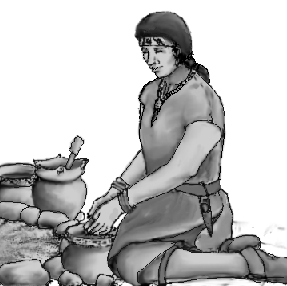
Pottery is assumed to have been made by women, there are few early historic references to men making pottery. All the women would learn to make pottery, there is no evidence for pottery specialization (pottery made only by a single person or village family). Maintaining a livelihood of hunting, gathering, and horticulture, full-time professions would take energy away from daily subsistence activities, as every member needs to devote time to the daily food quest. Without such specialization, an artist can still find creative expression within the realm of everyday life, based on their daily experiences. Because Native Americans in southern New England organized themselves to move from one non-permanent settlement to another, their art focused on the decoration of utilitarian objects, which were carried along, left for later use or buried with the deceased. Through the perfection and embellishment of these items, Native Americans found not only a means of individual expression, but they also discovered a way to communicate important cultural symbols.
Natural clays formed when minute particles carried by streams sank and settled in still water ponds. For Native Americans to use natural clay dug from pond sides, river banks or ocean cliffs it had to be plastic enough to be bent or stretched into a coil without breaking or cracking. Often the clay had to be specially prepared. Native Americans added temper, crushed shell, sand, crushed fired-pottery, or even plant material to fine homogenous clays to help pottery withstand the shock of rapid-temperature changes and open flames. In preparing to make a pot all impurities were removed from the clay and any trapped air pockets or bubbles had been removed by wedging or kneading the clay, only then was the clay ready for rolling into coils for construction of a pottery vessel.
Native Americans in New England started making a pot by pinching a small ball of clay into a dish shape and placing it in a hollow in the earth. Turning the vessel during production, coils of clay were successively added to the interior of the vessel wall. The coils were pinched or pressed and smoothed into the previous coil, which welded the coils of clay together. The coiling process spiraled upwards until the desired form was achieved, at which point the vessel was paddled with a cord-wrapped stick to further compress and cement the clay, and give the pot it's finished form. Ceramic pots made by Natives of the Eastern Forest had slightly pointed, and later in time globe-shaped bottoms, like the bottom half of an egg . The rounded bottoms of the pots were perfectly suited to the uneven surfaces of the woodlands, and remained upright easily when placed in a hollow or upon rocks.
Pottery was fired outside in a shallow pit, without the use of an enclosed kiln. Temperatures in wood firings probably reached 1500o. After firing, pottery pieces are as hard as rock and can last for thousands of years buried in the earth.
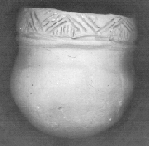
|
Miniature Pot. |
At first pots were used mainly for cooking, but later in time pots were used to store foods as well. Pottery mainly consisted of cooking vessels, but miniature pots, pipes, beads and figurines were also made. Miniature pots (½ foot to 1 inch diameters) have been found by archaeologists working in New England. In Rhode Island, Archaeologist William Simmons unearthed small pots that were buried with 17th century Narraganset. It is likely small pots were used to prepare special foods required of young child, who may have been recently weaned, and would subsequently be needed by the child in their journey after death.
In addition to those made of stone, smoking pipes made of clay have been recovered from Early, Middle, and Late Woodland Period archaeological sites in New England. A variety of plant materials, primarily sacred aboriginal tobacco, were smoked for their curative values, and probably for recreation. The motifs and designs found on clay pipes are similar to those found on clay pots. Some pipes made with clay bowls and metal stems.
 | 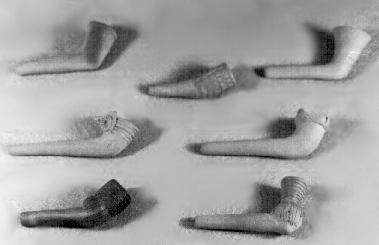 |

|
Pieces of pottery found by archaeologists can tell much about
the way people lived long ago. Pottery can tell archaeologists
about a peoples' artists and their tools, and also about how and
what they cooked and ate. Decoration and style tell us about who
made the pottery and the ties between different groups of people.
The changing shapes of pots, or vessel forms of southern New England pottery over time reflected
the concurrent changes in food types and cooking methods. Early
pointed-bottom pots, designed to sit directly on the fire, are
best for quickly boiling meat and other food. Later rounded-bottom
pots were designed to be farther from the fire for slower simmering
of a variety of grains and vegetables in addition to meat. The
constricted necks of later pots allowed the pot to be suspended
with cords over the fire and the amount of liquid lost from the
simmering food was also reduced.
Decorations were then applied, stamped
or incised, and the body of the pot was often smoothed over.
Various tools were used by Native Americans
of southern New England to decorate their pots, including carved
antler modeling tools, toothed combs, pointed sticks, scallop
and probably other shells, nets and textiles to impress, wooden
or shell scraping tools, and burnishing stones. Clay pots were
decorated with designs and motifs used for other forms of art
like metal-working, weaving, and even face painting. These shared
designs encompass zones broken-up into triangles, zig-zags, and
dots. Between 3,000 and 1200 years ago, designs and pottery styles
appeared over much of southern New England with showed little
variation from one area to the next, suggesting that these designs
were shared by many different groups of people.
By the end of the Middle Woodland Period,
1200 years ago there was an increase in the diversity and complexity
of designs placed on pottery. As the Native American population
in southern New England increased and groups began to live in
one place for longer periods of time, there is a corresponding
increase in the stylistic diversity of ceramic decorations. This
correspondence may reflect a need for groups of Native Americans
to express their own family/village identity in the face of encroaching
neighbors.
The designs applied to Late Woodland
pottery, made by Mohegan, Pequot and Narragansett tribes in the
historic period, preserve design elements from earlier times,
including incised and stamped zones of horizontal, vertical, and
triangular or zig-zag elements. In examples from the historic
Mohegan Fort Shantok site, the pots have a unique sculptural quality
which includes modeling of the vessel surface to raise lobes below
the vessel collar, and elaborately formed castellated rims with
one or more projecting points. Many of the later modeled, castellated
decorations depict images of birth, fertility and other feminine
qualities.
William Wood noted in 1634 that: "Hence
likewiƒe our Indians had their pots wherein they uƒed
to ƒeeth their victuals before they knew the uƒe of
Braƒƒe"; kettles made of iron, brass and copper
acquired in trade became more popular than traditional ceramic
vessels. Many reasons lead to the decline of Native pottery production,
metal kettles were sturdier and more portable than traditional
pottery, and when they were damaged, could be repaired using sheet
metal acquired in trade with Europeans. During the Fur Trade
and Colonial-Native wars, time expended in pursuit of furs and
producing wampum tributes took energies away from many traditional
craft industries. Metal kettles and other trade items were soon
adopted by Native Americans into traditional cultural roles.
By the late 17th century metal pots and other European
items even replaced many traditional items, such as clay pots,
in burial offerings.
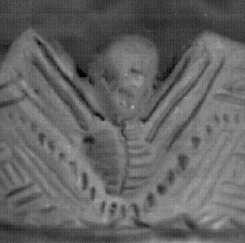
(reproduction).

|
Text and Graphics
© 1994 - Tara Prindle unless otherwise cited. |